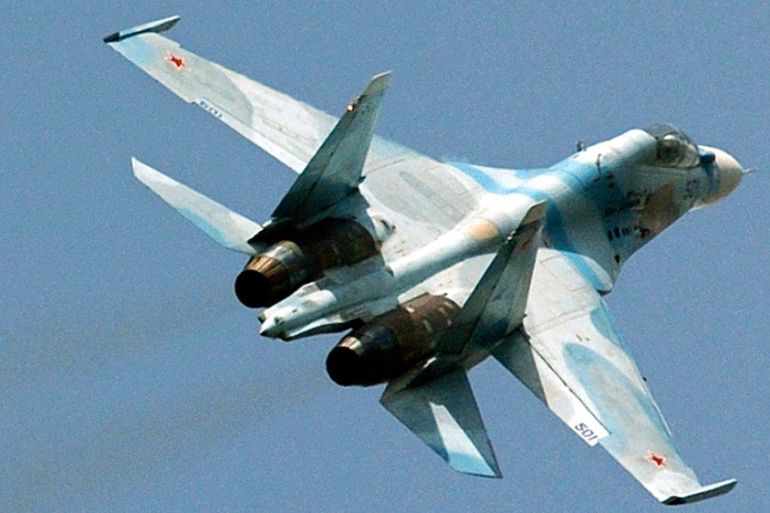Chinese jet ‘flies upside down’ over US spy plane
Fighter jets carry out what US describes as ‘unprofessional’ intercept of radiation detection plane over East China Sea.

Two Chinese fighter jets have carried out what the US military described as an “unprofessional” intercept of a US aircraft designed to detect radiation while it was flying over the East China Sea.
US officials told CNN that one of the Sukhoi Su-30 jets that approached the WC-135 plane on Wednesday was flying upside down, coming as close as 46 metres.
Keep reading
list of 4 itemsMarcos Jr treads fine line with China as Philippines deepens US, Japan ties
Japan, Philippines, US rebuke China over ‘dangerous’ South China Sea moves
Biden, Japan leader Kishida announce stronger defence ties in state visit
“The issue is being addressed with China through appropriate diplomatic and military channels,” air force spokeswoman Lieutenant-Colonel Lori Hodge said on Thursday.
Chinese foreign ministry spokeswoman Hua Chunying declined to comment on the specific incident and referred questions to the defence ministry which has yet to comment.
“For a long time US ships and aircraft have been carrying out close-up surveillance of China which can really easily cause misunderstandings or misjudgments or cause unexpected incidents at sea or in the air,” she told the Reuters news agency.
“We hope that the US side can respect China’s reasonable security concerns.”
READ MORE: US slams China over spy plane ‘provocation’ (2014)
US television network NBC reported that the US aircraft was conducting a routine mission in international airspace when it was intercepted over the East China Sea.
The WC-135 is a so-called “sniffer plane” designed to scan the atmosphere for signs of nuclear activity.
US broadcaster NBC said the WC-135’s crew described the encounter as “unprofessional”, although not necessarily dangerous.
It said military officials insist the US plane was operating in accordance with international law.
A similar incident occurred in 2014, when then-President Barack Obama said that Chinese fighter jets conducted an “unprofessional” intercept of a US navy spy plane in international airspace over the South China Sea.
Washington and Beijing have differing views about the legality of US military overflights in much of the region, a result of differing interpretations of rights conveyed under the Law of the Sea treaty.
In April 2001, another intercept of a US EP-3E spy plane by a Chinese F-8 fighter in the same area resulted in a collision that killed the Chinese pilot and forced the US plane to make an emergency landing at a base on Hainan.
The 24 US crew members were held for 11 days until Washington apologised for the incident, which soured US-Chinese relations in the early days of President George W Bush’s first administration.
The US and Chinese militaries have boosted their contacts in recent years amid recognition that – as China’s economic interests continue to expand – it will play a bigger security role in the world and have more interactions with the US military.
But even as US and Chinese military contacts have increased, tensions between China and its neighbours, some of them US treaty allies, have heightened over competing territorial claims in the South China and East China seas.